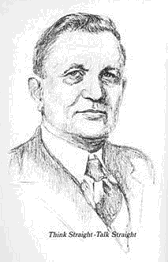|
|
|
|  |
|
| | | The son of John William and Mary Aabye Andersen was born on May 30, 1885, in Plano, Illinois. He was graduated from Atheneum High School, Chicago, in 1903.
He received a bachelor's degree from Northwestern University in 1917. Honorary Doctor of Laws degrees were conferred upon him by Luther College in 1938, and by Northwestern University, Grinnell College, and St. Olaf College in 1941. He was certified as a CPA in 1908 (Illinois); he was the youngest CPA in Illinois at that time.
From 1901 to 1907 he was employed by Fraser & Chalmers Company, which later became a part of Allis-Chalmers Manufacturing Company. In 1907 he joined Price Waterhouse & Co. as a senior accountant, the position he held until 1911 when he resigned to join Jos. Schlitz Brewing Company as controller. In 1913 he and a partner established the firm now known as Arthur Andersen & Co; he served as senior partner until his death.
He was active in professional organizations, serving as president (1918-19) of the Illinois Society of CPAs and serving on the Illinois Board of CPA Examiners (1926-28). He served on various committees of the AICPA, including the Committee on Form and Administration of Income Tax Laws (1923-24) and was the chairman of the Special Committee on Definition of Earned Surplus (1924-30). Other professional affiliations included membership in AAA and the American Economic Association.
He devoted much of his time to accounting education. While practicing accounting, he was associated with Northwestern University as lecturer (1909-12), assistant professor (1912-15), and professor (1915-22). He also served as head of the accounting department from 1912 to 1922, when he resigned to devote full time to his professional accounting practice. He wrote numerous articles for professional journals and he authored Complete Accounting Course (1917). He also authored the following in pamphlet form: Financial and Industrial Investigations (1924), The Major Problem Created by the Machine Age (1931), Duties and Responsibilities of the Comptroller (1934), The Future of our Economic System (1934), Present Day Problems Affecting the Presentation and Interpretation of Financial Statements (1935), and A Layman Speaks (1941). He was a member of Alpha Kappa Psi, Beta Alpha Psi, and Beta Gamma Sigma.
Active in civic and community services, he was president, Chicago Home for the Friendless (1923-25); member (1927-32) and president (1930-32), Board of Trustees, Northwestern University; trustee, Century of Progress, Chicago (1933-34); president, Norwegian-American Historical Association (1936-42); director, State Bank & Trust Co. (Evanston, Illinois); and member, Taxation and Finance Committees, U. S. Chamber of Commerce. He was decorated in 1940 by the Norwegian Government with the Knight Commandees Cross of the Royal Order of St. Olav.
He married Emma Barnes Arnold on August 8, 1906; they had three children. In his leisure time he enjoyed golf, fishing, reading, photography, travel, music, and art. He died on January 10, 1947 at the age of 61. |
| | | Basic Background |
| In 1913 the establishment of the Federal Reserve System and the federal income tax lead to a rise in demand for accounting services. At this point Arthur Andersen broke away from his firm Pricewaterhouse, and with Clarence DeLany formed Andersen, Delany & Company, a rival accountancy. When Delany left in 1918, the firm became known as Arthur Andersen & Co.
The firm grew rapidly and branched into the consulting area, conducting financial investigations for companies. Andersen died in 1947 and Leonard Spacek succeeded him as the head of the firm. Spacek oversaw a huge growth in the size of the company in America and also began expanding abroad.
The consulting branch became a separate entity within the Andersen group in 1954 and was called Andersen Consulting. Although it was successful it only accounted for 20% of revenues by 1979. Things changed dramatically during the mergers and acquisitions boom of the 1980s and by 1988 Andersen Consulting was generating 40% of the combined company profits.
The rift developed further when Andersen Consulting's share of the business grew to more than 50%, nor was the situation aided when the accountants formed another consultancy arm, aimed at small businesses. As accountants became increasingly liable for the fiscal misdeeds of their clients, consultants began to see the accountancy side as a burden to their business. This tension came to a head in 1997 when CEO Lawrence Weinbach announced his retirement and an accounting partner, Robert W. Grafton was appointed in his place.
The final split did not come until 1999 when the International Chamber of Commerce ordered that Andersen Consulting pay $15 billion in compensation for withholding fees or pay $1 billion in compensation and discontinue using the Andersen name. Andersen Consulting opted for the latter and spent $175 million re-inventing themselves as Accenture. |
| | | Corporate Culture |
| The company was rated as one of the top 100 US firms to work for by Fortune Magazine and The Sunday Times placed the group in their top 50 in the same category. They were also known for pleasing their clients, and came top in the '2000-2001 Big Five U.S. Multinational Companies Client Satisfaction Study.' conducted by Emersen Research Company. Andersen particularly promoted the straight talking nature of the company.
Employees shared in the success of the firm, receiving shares of the profits whenever it exceeded its targets. Personal achievement was also very well rewarded. The vast global network of Andersen provided abundant opportunities in diverse locations for all employees, but despite their size Andersen emphasised the unity of their approach all over the world, summed up in their most recent catchphrase 'The Andersen Way'. |
| | | Source:
Accounting Hall of Fame
Ohio State University
Fisher College of Business
|
| | | If you have any suggestions for this section, please send them to admin@AndersenAlumni.com |
| |
| |
|
|
|
|
|
|
|
|
|
|
|
| |